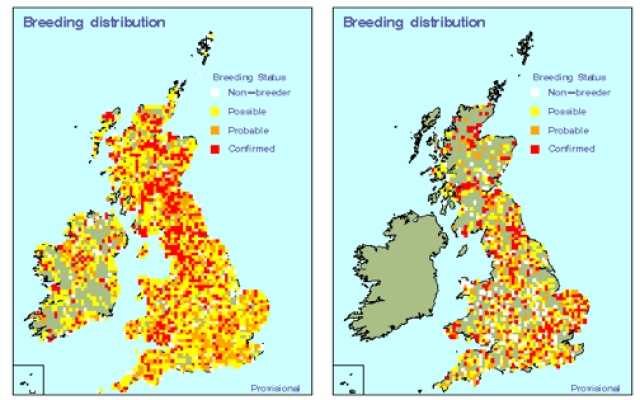With just over a week left of the official breeding-season fieldwork period for the Bird Atlas, many birders are out completing their late visits to their tetrads (2 x 2 km squares). These timed counts in tetrads will give us information of the relative abundance of species at the 10-km square level. We're aiming to achieve timed counts in a minimum of eight tetrads in each 10-km square whilst those counties/areas undertaking local atlases (36) will be aiming for a much higher level of coverage.

Robin, Padley Gorge, Derbyshire (Photo: John Dickenson)
In addition to these Timed Tetrad Visits, thousands of birdwatchers have been out gathering Roving Records for the distribution maps and, crucially in this season, trying to record the highest level of breeding evidence for each species in a 10-km square. For some species this is easy—seeing an adult Robin feeding young ones is a sure sign that Robins have bred locally. Some of us might be lucky enough to have Swift, Swallow or House Martin nesting around our homes—an easy way to confirm breeding. For other species, a lot more time is needed to confirm breeding. The maps below for Willow Warbler (left) and Tawny Owl (right) show the levels of possible, probable and confirmed breeding status in each 10-km square.

Even for a common and widespread species like Willow Warbler there are still many 10-km squares where the species has been recorded from but yet to be confirmed breeding, including many well-watched birding areas! For nocturnal species like Tawny Owl, Woodcock and Long-eared Owl a lot more effort, skill (and luck!) is required to confirm breeding. Birders out in the evening may well come across some of these species and can usefully contribute records to the Atlas.
So what does it take to 'confirm' breeding? The codes used in Atlas work are listed below:
DD—Distraction—Display or injury feigning
UN—Used Nest or eggshells found from this season
FL—Recently fledged young or downy young
ON—Adults entering or leaving nest-site in circumstances indicating occupied nest
FF—Adults carrying Faecal sac or Food for young
NE—Nest containing eggs
NY—Nest containing young seen or heard
Watching for birds carrying food or faecal sac (FF) is perhaps one of the easiest ways to confirm breeding. Careful consideration should be given to the likely provenance of any fledged juvenile capable of significant geographical movement (FL). Evidence of dependency (e.g. feeding) is helpful, so watch out for adults still feeding young. It's surprising how far recently fledged juveniles can move so you need to be sure they bred in the tetrad or 10-km square.

Spotted Flycatcher, Weeting Heath NWT, Norfolk (Photo: Richard Jones)
How you can help
There is still plenty of time to add Roving Records for this breeding season. You can continue to record breeding evidence during August for late-nesting species such as Spotted Flycatcher. You can add Roving Records via the Atlas website (www.birdatlas.net) and use the Google map facilities to help you find your grid references. If you are not already signed up as a BTO online user, click the red button on the homepage. Once you've added a Roving Record for a specific 10-km square or tetrad, you can then view all the other species recorded in that area (except rare and scarce birds which are omitted from the list) via the 'Square Summaries' in Data Home. Perhaps you can help fill in some gaps?
Thank you!
Many thanks to the thousands of birders that have contributed to the Atlas so far—and found some good birds along the way! Fieldwork for the winter starts on 1st November and we are looking for skilled birders to take on Timed Tetrad Visits across Britain and Ireland. Just two visits are required in the winter and breeding season to each tetrad and then it is complete. If you can help out, look at www.birdatlas.net for where help is needed or contact Dawn Balmer at BTO (telephone: 01842 750050 or email).

